The Surface 3 Review
by Brett Howse on May 4, 2015 9:00 AM ESTSystem Performance
Since the Surface 3 is a tablet that can replace your laptop, comparisons will be made between both devices. Because the new tablet is running full Windows 8.1 x64, it is possible to run the full benchmark suite that we have for laptops. On the tablet side, there are not a lot of cross-platform benchmarks so the only thing that can really be used is browser based tests. It is not ideal, but we have to work with what we have.
To summarize the Surface 3, it is powered by the top model of the latest Intel Atom 14nm stack. The Atom x7-Z8700 is a quad-core processor with a base frequency of 1.6 GHz. The CPU can turbo up to a maximum of 2.4 GHz, and all of this is done within a 2 watt Scenario Design Power. The review unit that I received is the $499 unit, so it only has 2 GB of LPDDR3 memory rather than the 4 GB offered on the higher priced model.
For comparisons against tablets, I have selected a sampling of several devices that have already been reviewed. Some of the devices are running on ARM processors, and several of the Windows ones run on Intel Core M, with a few more running on previous Atom architectures. To compare this device against any other device we have tested, please check out our Mobile Bench.
Tablet Performance
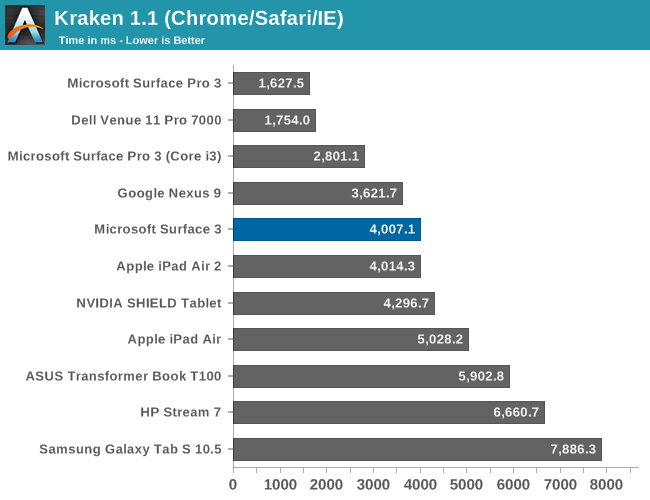
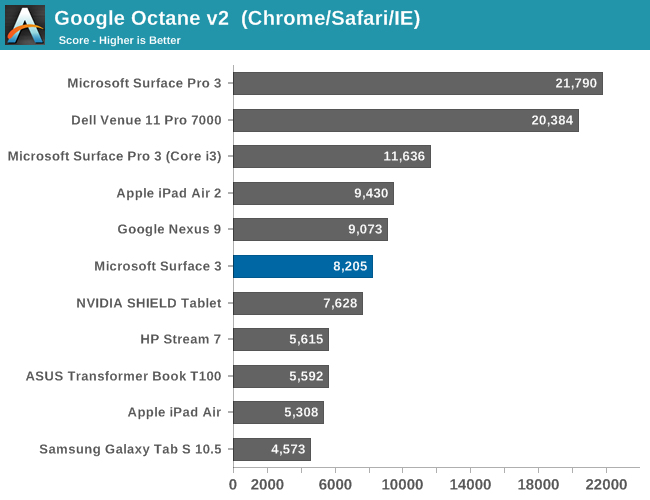

Since we just have web benchmarks to compare against other platforms, it does make it difficult to get a true feel for how Atom compares to the best, but when comparing to ARM processors it is fairly competitive. All of the web benchmarks are done using Chrome (hopefully we can switch to Microsoft Edge soon) because IE 11 has pretty awful javascript performance. Atom is a long ways off of the Core series in the Surface Pro line, and well back of the Core M powered Dell Venue 11 Pro tablet. There is a big jump in performance compared to the Bay Trail ASUS T100 and HP Stream 7. That is important since Cherry Trail is not a big architecture update, but mostly a process shrink, so the 14 nm processes can keep everything running at higher frequencies in the same power envelope.
Laptop Performance
By attaching the keyboard, the Surface 3 becomes a pretty reasonable laptop, so to see how much of a performance drop off there is with tablet class parts, the Surface 3 was run through our Laptop suite as well. The Atom is also equipped with eMMC storage, and some of the tests like PCMark take storage into account. Other benchmarks like Cinebench and x264 are CPU only. To compare the Surface 3 against any other laptop we have tested, please use our Laptop Bench.
PCMark

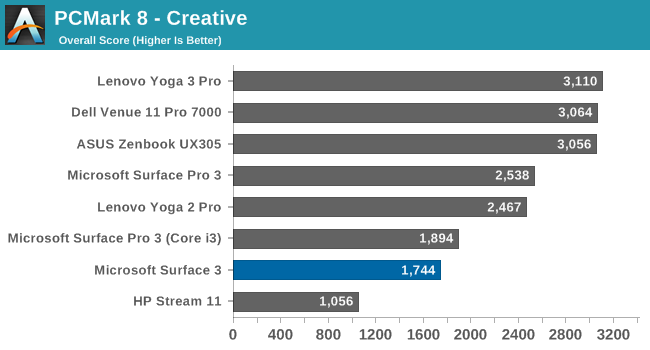
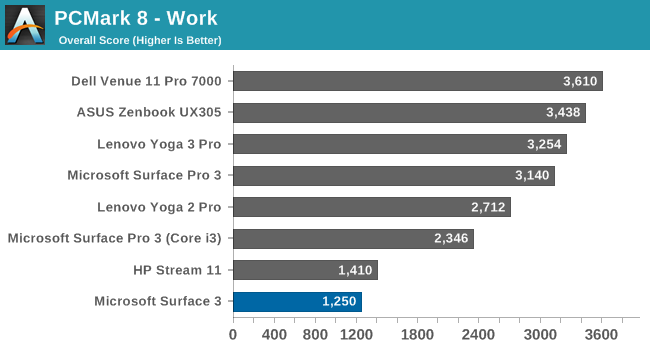
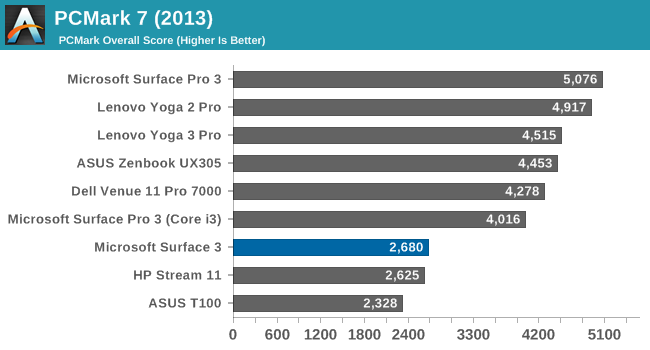
PCMark 8 from Futuremark has several benchmarks within it, all with the goal of simulating real-world use cases for each of the scenarios. It includes Home, Creative, Work, and Storage benchmarks. The workloads generally include both burst and sustained performance. The Atom can’t compete with the bigger Core pieces, but it is actually surprisingly close to the Core i3 Surface Pro 3. I think this is less about Atom and more about how handicapped Core i3 is with its lack of Turbo.
TouchXPRT


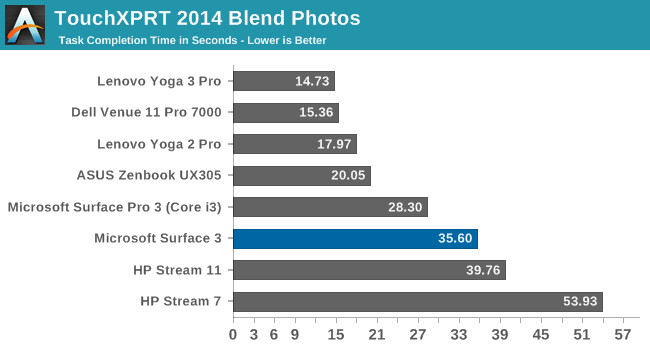
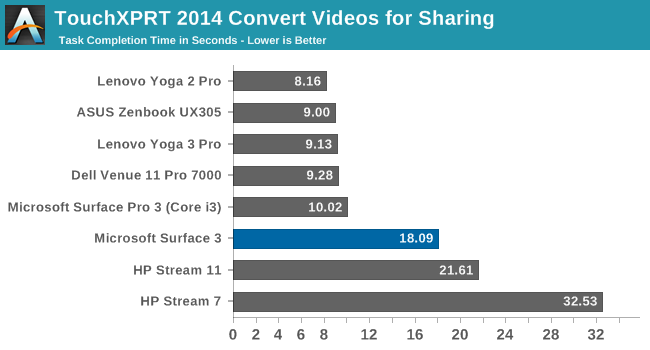
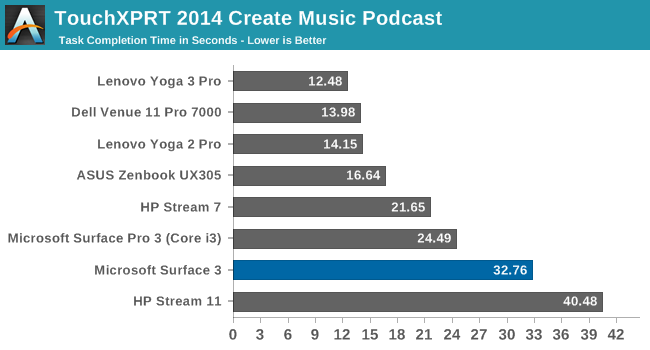
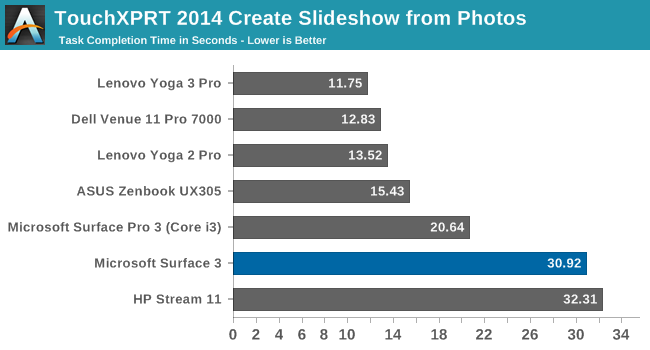
TouchXPRT 2014 is a benchmark that has a lot of burst workloads. The tasks are quick, but heavy, and it gives the processor a quick chance to cool off between each one so normally it is good about not running into throttling behaviour. The Atom processor is a long way off of the Core series here, with the exception of the i3 Surface Pro 3 which has no turbo capability. However there is a good bump in performance over the previous generation Atom in the HP Stream 7.
Cinebench

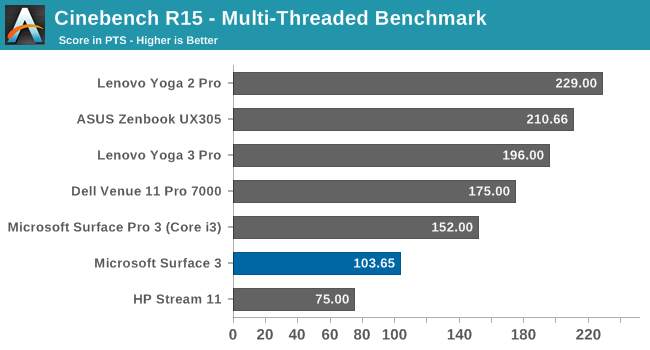
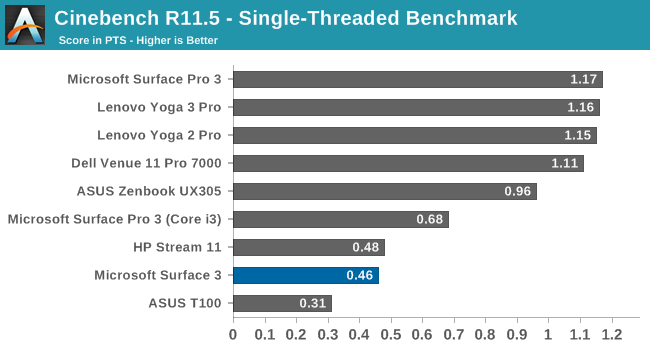
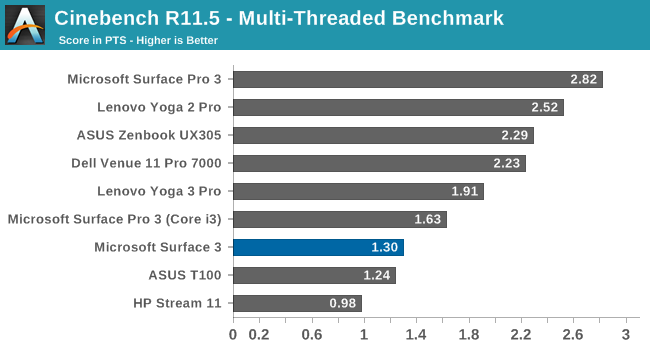
Cinebench is purely a CPU task, and it loves Instructions Per Clock (IPC) and frequency. There are two modes here with a single CPU run and all core run. It is still a long ways back of the Core i3 Surface Pro 3 on this test, and despite the Atom processor having four physical cores and the Core processors having only two physical and four logical cores, it is still not enough on the multithreaded run to really close the gap, although it does slightly. Looking at version 11.5 of this test, we have more data going back to older devices, so there are scores available from the ASUS T100 and there is a bump in performance compared to Bay Trail.
x264
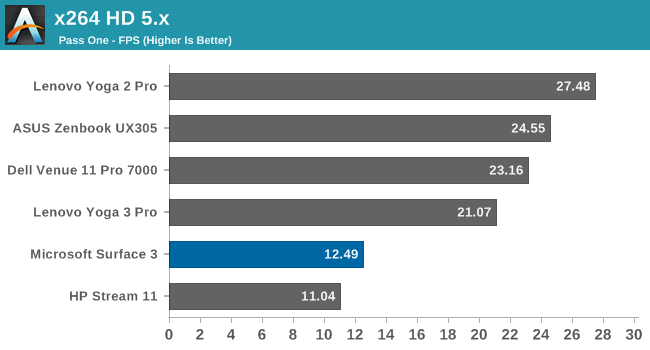

Once again this is a benchmark that prioritizes good IPC and frequency, along with multiple cores. The Atom struggles here compared to Core, which at this point should not be a surprise.
So clearly the new Cherry Trail CPU cores are not a giant leap in performance over Bay Trail, but like Haswell to Broadwell, there is a decent bump and the better manufacturing process helps increase overall performance due to the additional thermal headroom in the same power envelope. However when comparing it to the ARM competition, we only have a few data points but it does seem to be about on par with the top ARM CPUs at this time. Comparing devices across different operating systems is always difficult though.
Using the device day to day as a tablet though, performance was good. Yes, it could be better, and devices that use Core M are going to be able to run circles around Atom, but at the cost of additional heat. One of the nicest surprises of using this tablet was that it just never got warm at all, and the same cannot be said of any of the passively cooled Core M devices. Sure, when running very heavy benchmark loads, there was a bit of heat on the back, but it was never much more than around 30°C or so.
My experience was that when the Surface 3 felt slow, it was often not CPU bound but disk bound.










265 Comments
View All Comments
meacupla - Tuesday, May 5, 2015 - link
Proprietary connectors only suck when they are easy to break and hard to replace.That said, micro USB connectors also suck on these devices, because they're also easy to break and hard to replace.
The magnetic reverseable connector on previous surface devices was perfectly fine. They were hard to break and easy to replace. Basically, the side that broke most often was either the cable or brick, which is much cheaper to fix or replace compared to the device itself.
ddawg609 - Monday, May 4, 2015 - link
Will it upgrade to Windows10 when it is released?BlueBomberTurbo - Monday, May 4, 2015 - link
Yup, everything that uses Windows 7 through 8.1 can be upgraded to Windows 10 for free for the first year of release.mva5580 - Monday, May 4, 2015 - link
As it seems with most devices these days, my main concern is with battery life.What I really want it to be is an iPad replacement that also happens to be a full PC. I'm fine with the price point (an 128gb iPad Air 2 without a case/keyboard is $700,) I'm fine with the performance (I will play games on it, but stuff that it can handle. SimCity 3000, Baldurs Gate, Out of the Park Baseball, stuff like that,) and the form factor is small enough to feel like a tablet but big enough to be able to do most "full" PC things on it.
It just seems like whenever I look at devices anymore, I'm disappointed in the battery life. So I guess either my expectations are too high, device makers don't care as much about battery life and skimp on it, or maybe a little of both. If this thing could manage the battery life of an iPad Air 2, it would dare I say, be about as "perfect" of a device as I could find for what I want to do with it. For many years to come at least when things this size can run newer, more advanced games.
I have the bundle pre-ordered from Costco that is the 4gb/128gb/Pen/Keyboard combo for $700, and I'm very much looking forward to trying it out. If the battery life isn't a disappointment, I imagine I will love it.
jjj - Monday, May 4, 2015 - link
This is a bulky and very heavy (622 g) mid range tablet and they want 500$ for it.Plus 129 $ for crappy keyboard.And it runs Windows, M$ will never get tablet apps going before tabs are dead. A crippled tablet and a crippled netbook merged into something nobody needs. Some might think they need it but that's only because they don't know any better and you are not helping them.
How hard you try to sugarcoat the pref is also rather hilarious. In GPU you go as far as flooding the reader with synthetic benchmarks (decades of PC benchmarking improvements down the drain) just to hide the single gaming perf numbers at the end.
I thought that after Anand left , the site is regaining some of it's lost objectivity but i guess you are still full steam ahead when it comes to "supporting" certain industry players.
Who payed for that trip to M$'s event last week?
mva5580 - Monday, May 4, 2015 - link
Yes, and you don't sound biased in any way whatsoever. "Bulky and very heavy" in comparison to what, exactly.You're choosing to classify it as a "tablet," can you give an example of a tablet with a similar form factor that is smaller, lighter, and cheaper that runs full Windows?
jjj - Tuesday, May 5, 2015 - link
Bulky and very heavy in compared to the vast majority of tablets. Do the math if you want for screen area per volume.How exactly is running Windows on 64GB of NAND and 2GB of RAM an advantage? If you are gonna just do Office and web browsing then you certainly don't need Windows. If yo want more, then you need more than this.As for the AR, it doesn't matter much and it's actually M$ trying to copy Apple and going just slightly different to not be called a clone. Pricing wise you can do 2x better.
damianrobertjones - Wednesday, May 6, 2015 - link
Ummm... Windows Tablets have been around for a long, long, LONG time. Archos 9, UMPCs, Mids, plus many, many more types.Geodude074 - Saturday, May 9, 2015 - link
Asus T100 Chi vs Surface 3- $450 for tablet/keyboard combo vs $630 for tablet/keyboard combo.
- 1.3 lbs vs 1.4 lbs.
- 1920x1080 vs 1920 x 1280.
- Same 2 GB RAM.
- Same 64 GB storage.
- Same full Windows.
- Z3775 vs Z8700 (the only advantage Surface 3 has).
Is it worth spending ~$200+ for the Atom x7? In my opinion, no not really.
devione - Monday, May 4, 2015 - link
Jesus Christ. I stopped reading at "bulky and heavy".If you find 622g bulky and heavy, you really need to get your life sorted out.